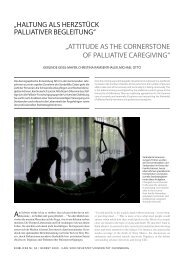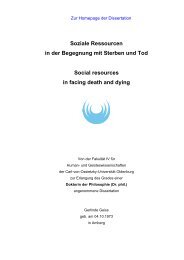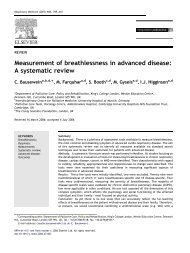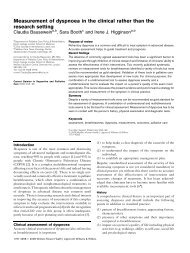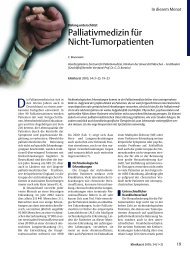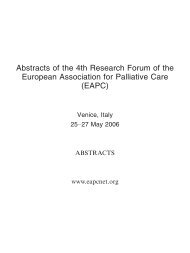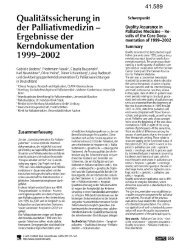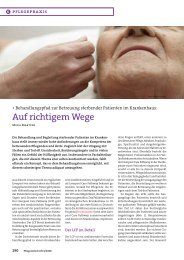EAPC - ipac
EAPC - ipac
EAPC - ipac
Create successful ePaper yourself
Turn your PDF publications into a flip-book with our unique Google optimized e-Paper software.
404 <strong>EAPC</strong> Abstracts<br />
larger study of 100 patients newly referred to a hospice community palliative<br />
care service in Central Scotland. A grounded theory and narrative approach<br />
was taken to analysis. Results: Key themes were physical (debility, dependence<br />
and expectations); psychological (understanding, uncertainty and vulnerability);<br />
social (communication and family) and spiritual (faith, reflection<br />
and hope). The unifying theme was control. Over the time from referral to<br />
death, patients’ perspectives evolved in a positive direction: Patients adapted<br />
and became reconciled to death. Despite this positive trend, all of the patients<br />
suffered transient negative episodes related to acute, unpredictable exacerbations<br />
of distress in any one of the physical, psychological, social or spiritual<br />
domains. The distress was induced by a sudden change in circumstances<br />
inconsistent with the established and familiar pattern of change.<br />
Conclusions: For patients with advanced cancer, perspectives on illness<br />
relate to physical, psychological, social and spiritual factors. The fundamental<br />
issue is control maintenance. Patients appear to become reconciled to<br />
death, facing it positively, despite experiencing periodic, unpredictable, acute<br />
exacerbations of distress. These episodes, which occurred throughout the<br />
final journey, reflected the transient loss of control associated with unexpected<br />
change. The process of adaptation continued once control was regained.<br />
16 Oral Presentation<br />
End of life care and quality of death<br />
How effective is the control of and communication about agitation<br />
and distress in the last 48 hours of life<br />
Authors: Joanna Dunn Medicine St Christopher’s Hospice UNITED<br />
KINGDOM<br />
Emma Hall St Christopher’s Hospice London UNITED KINGDOM<br />
Jane McManus St Christopher’s Hospice London UNITED KINGDOM<br />
Holly Young St Christopher’s Hospice London UNITED KINGDOM<br />
Background: The prevalence of end of life sedation appears to be increasing.<br />
There is insufficient evidence about effectiveness of medication and communication<br />
with patients/families. Aims: Relate sedative dose titration and drug<br />
review to effectiveness of relief of agitation in the last 48 hours of life.<br />
Identify areas for improvement. Methods: Retrospective case-note review of<br />
last 48 hours of life of 100 consecutive hospice deaths. Results: 99 evaluable<br />
patients. Median age 73 years (range 33–93). 49 males. 90 had cancer. 69/99<br />
(69%) patients were agitated at some time in the last 48 hours of life. 117/273<br />
(43%) stat doses were recorded as effective. 46/115 (40%) stat doses of sedative<br />
at 48–24 hours pre death and 76/158 (48%) in the last 24 hours were<br />
given simultaneously with another drug, usually analgesia. The median number<br />
of stat doses per patient was 2 (range 1–10) at 48–24 hours and 2 (range<br />
1–9) in the last 24 hours. 29/99 (29%) required 3 or more stat doses in the last<br />
48 hours.57/99 (58%) patients received continuous infusions of sedatives in<br />
the last 48 hours of life, of whom 22/57 (39%) had an increase or change in<br />
the last 24 hours and 11/57 (19%) required combinations of sedatives.<br />
Midazolam was the most frequently used drug for both continuous (median<br />
20mg; range 5–100mg) and stat use (median 2.5mg; range 1.25–20mg), followed<br />
by levomepromazine (median continuous dose 25mg; range<br />
6.25–250mg, median stat dose 12.5mg; range 6.25–50mg). 3 patients<br />
required phenobarbital. There were discussions about sedation with families<br />
in 30/68 (44%) cases. Conclusions: Agitation was common in the last<br />
48 hours of life, sometimes intermittently. Documentation of communication<br />
and drug effectiveness could be improved. Doses were similar to previous<br />
studies. Issues for further investigation include co-administration of sedatives<br />
and analgesics, dose titration of stat and continuous doses and the use of<br />
sedative drugs in combination for more resistant agitation.<br />
17 Oral Presentation<br />
End of life care and quality of death<br />
Palliative Care in Dutch Nursing Homes: Dying with Dignity<br />
Authors: Luc Deliens Dept. of Social Med. Vrije Universiteit Amsterdam-<br />
VUMC CANADA<br />
Dr. H Brandt VU Free University Medical Center Amsterdam<br />
NETHERLANDS<br />
Miel W Ribbe VU Free University Medical Center Amsterdam<br />
NETHERLANDS<br />
Background: Nursing homes (NHs) are less well studied than hospices or<br />
hospitals regarding palliative care. For palliative care information is<br />
≠needed about the patients, symptoms, direct causes and underlying diseases,<br />
and incidence of terminal ill NH patients. Methods: Prospective<br />
observational cohort study in 16 NHs in the Netherlands. All long-term<br />
care patients assessed by an NH physician to have a life expectancy of<br />
6 weeks or less were enrolled (n=516). The symptoms-and-signs list was<br />
constructed from the MDS-RAI2.0. The validated Dutch Classification of<br />
Diseases for Nursing Home Medicine (CvZ-V)16 was used for registration<br />
of the direct cause of the terminal phase and the underlying disease.<br />
Results: The terminal disease phase was marked with symptoms of low<br />
fluid and food intake, general weakness, and respiratory problems or dyspnea.<br />
Patients were frequently in a state of somnolence and experienced<br />
recurrent fever. Direct causes of these conditions were diseases of the respiratory<br />
system and general disorders. The 2 main underlying diseases of<br />
the terminal phase were mental disorders (dementia) and circulatory<br />
diseases. For both groups, symptoms of (very) little/no fluid intake, generalized<br />
weakness, somnolence and cachexia/anorexia were common. For<br />
patients with mental disorders (mainly dementia) the beginning of the terminal<br />
phase was marked with problems of nutritional intake, and recurrent<br />
fever. In the circulatory group, this beginning was mostly the presence of<br />
respiratory problems and/or dyspnea. Cancer was the underlying disease in<br />
only 12% of the patients, showing a different pattern of symptoms compared<br />
to residents without cancer. Conclusions: A wide variety of burdensome<br />
signs and symptoms are seen in the terminal phase of nursing home<br />
patients with fluid and food intake-problems, general weakness, and dyspnea,<br />
as the most important. For patients without cancer in Dutch NHs, the<br />
terminal disease phase is difficult to predict, and once diagnosed, patient<br />
survival time is short.<br />
18 Oral Presentation<br />
End of life care and quality of death<br />
Care for patients in the last three months of life: findings from<br />
the nationwide SENTI-MELC study in Belgium<br />
Authors: Lieve Van den Block End-of-Life Care Research Group Vrije<br />
Universiteit Brussel BELGIUM<br />
Nathalie Bossuyt Wetenschappelijk Instituut Volksgezondheid Brussels<br />
BELGIUM<br />
Viviane Van Casteren Wetenschappelijk Instituut Volksgezondheid Brussels<br />
BELGIUM<br />
Katrien Drieskens Vrije Universiteit Brussel, End-of-Life Care Research<br />
Group Brussels BELGIUM<br />
Sabien Bauwens Vrije Universiteit Brussel Brussels BELGIUM<br />
Reginald Deschepper Vrije Universiteit Brussel, End-of-Life Care Research<br />
Group Brussels BELGIUM<br />
Luc Deliens Vrije Universiteit Brussel, End-of-Life Care Research Group<br />
Brussels BELGIUM<br />
Background: The WHO has identified palliative care as an issue of great<br />
clinical and public health importance. However, data describing end-of-life<br />
care on a societal or population-based level are lacking. This is the first<br />
nationwide study to measure end-of-life care in a representative sample of<br />
dying persons, in terms of involvement of caregivers, access to specialist<br />
palliative care, treatment goals, and physical-psychosocial-spiritual components<br />
of care. Methods: We performed a one-year nationwide mortality follow-back<br />
study in 2005, Belgium. Data were collected within the Sentinel<br />
Network Monitoring End-of-Life Care (SENTI-MELC) study. All 205 general<br />
practitioners within the Sentinel Network of GPs, an existing epidemiological<br />
surveillance system representative of all Belgian GPs, reported<br />
weekly on the final three months of life of every patient in their practice who<br />
died non-suddenly. Results: We studied 892 deaths. GPs, nurses/geriatric



